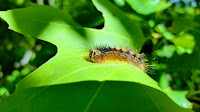WSDA Communications
 |
| Gypsy moth caterpillar on a leaf |
In May and June, WSDA’s pest program will conduct gypsy moth
caterpillar treatments in Kitsap, Snohomish, and King counties. Having been in many
of the spray areas in the 2016 and 2018 eradication projects, I want to let
people who live in or near one of the 2019
gypsy moth treatment areas what they can expect this year.
The day before treatments
 |
| Sign up to receive text, email or robo call notifications before treatments. |
Treatments are highly dependent on the weather, so WSDA
usually makes the final decision to spray the day prior to starting a treatment.
If you have signed
up for treatment notifications, you
will receive an email, text, or robocall the day before treatments begin. We
also posts notices of pending treatments in WSDA’s 2019 Gypsy Moth
Eradication Facebook group and on our Twitter account.
The product used to treat for gypsy moth caterpillars is Foray 48B. The
active ingredient is Btk – a soil bacteria. Foray 48B is approved for use on
organic food crops. Some people who live areas to be treated close their
windows, bring in outside toys, or cover their cars. It is sticky, so bringing
in or covering outdoor items will prevent the need to wash them off after the
treatments.
 |
| Cover cars and bring in or cover outdoor toys or wash them with soap and water after treatments to remove the sticky residue. |
If Btk does get on your car or other outdoor items, don’t
worry – it won’t damage them. But because it is sticky, you will probably want
to wash it off with soap and water. In 2016, I had the same car and was in the
spray zone for several treatments over a few weeks and one trip through the
carwash removed all of the sticky residue. Luckily, Btk is much easier to
remove than gypsy
moth caterpillar droppings!
Treatment day
Gypsy moth caterpillar spraying starts as early in the
morning as possible – usually around sunrise (the pilot cannot legal spray in
the dark) if the weather is good. Fog or wind, for example, can delay or even
cancel spraying for the day.
The treatments will be conducted by airplane. The plane is
red and white. It will fly over the treatment area at a relatively low altitude
– about 250 feet above the ground.
The plane will make several passes over each treatment area
until the entire area has been covered. The plane has guidance systems and GPS
to make sure that it is on target. The release of the Btk automatically starts
when the plane enters the treatment area and stops when the plane leaves,
ensuring that only the target area is treated.
The spray comes out in a very fine mist. It is so fine, in
fact, that if you are outside when the Btk is applied you will not even feel
the spray. You will notice an odor in the air; it has a bit of an earthy scent
to it. While you can see the product immediately after it comes out of the
plane, you really can’t see if when it comes down, except for the speckled
sticky residue it leaves.
The Washington State Department of Health says that Btk –
and Foray 48B specifically – poses very low risk to human health. Still, if you
want to avoid contact with the spray, the Department of Health recommends
remaining indoors during the spray and for 30 minutes afterward. If you do come
in contact with the spray, they recommend washing with soap and water. I was in
the spray area several times in 2016 and 2018 and didn’t have any problems.
Even with its excellent safety record, if you believe you
have had some reaction to the spray, you should see your doctor and/or report
it to the Department of Health at 1-877-485-7316.
After treatments
When each treatment is completed at each site, those who
have signed up for notices will receive a text message or robocall. When
treatments at both sites are complete, an email message will go out to those
who have signed up for email alerts. We will also have real-time updates on
Twitter and in our Facebook group letting people know when treatments are
complete.
Because the gypsy moth caterpillars emerge at different
times at the various treatment sites and because Btk breaks down quickly in the
environment, each site will be treated at least three times, with 3-14 days
between treatments depending on the weather. You can expect the same process
described above for each treatment. We expect to complete all treatments by
mid-June.
Summer trapping
After all gypsy moth caterpillar spraying is complete, the
next step will be to conduct intensive trapping for two years. This confirms
the success of the eradication project. You will likely see our traps in trees
in your neighborhood or along a road. Please do not disturb them.
If you have any questions about the eradication project or
our gypsy moth program, you can visit our website at agr.wa.gov/gypsymoth, email us at gypsymoth@agr.wa.gov, or call
our gypsy moth hotline at 1-800-443-6684.

